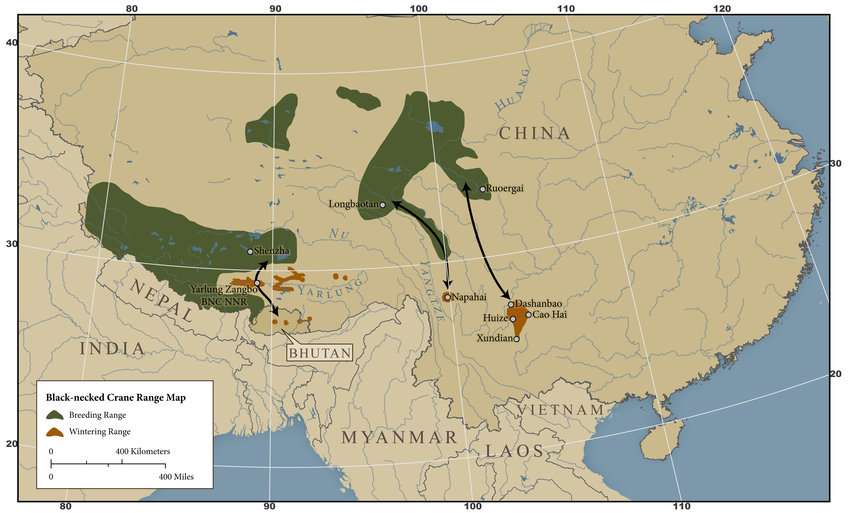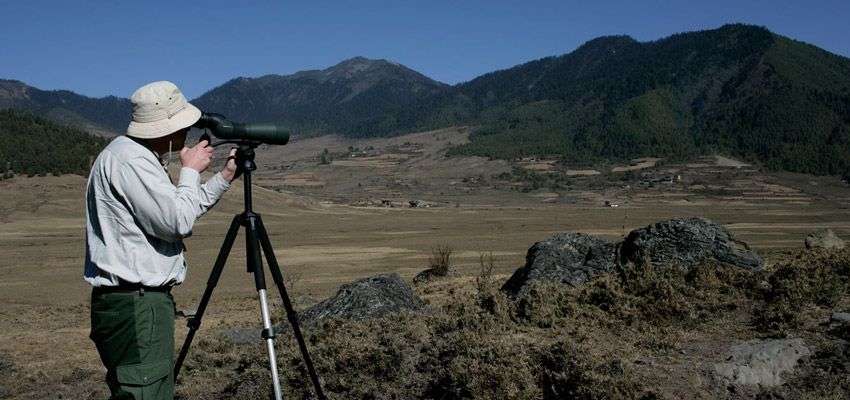Every winter, the pristine valleys of Bhutan welcome some very special visitors: the endangered black-necked cranes. These magnificent birds, revered in Bhutanese culture, make an epic journey across the Himalayas to spend their best winters in the kingdom’s glacial valleys. Let’s explore the fascinating world of Bhutan’s black-necked cranes and why they’re a must-see for nature enthusiasts and cultural travelers alike.
Key Takeaways:
- Black-necked cranes are endangered birds that winter in Bhutan
- Phobjikha Valley is the primary wintering ground for these cranes
- The birds are deeply connected to Bhutanese culture and Buddhist traditions
- Conservation efforts in Bhutan are crucial for the species’ survival
What Are Black-Necked Cranes?

The black-necked crane (Grus nigricollis) is a large wading bird native to the Tibetan Plateau. Key facts include:
- Height: About 1.3 meters tall
- Wingspan: Up to 2.3 meters
- Distinctive features: Black neck and head, light gray body, red crown patches
- Conservation status: Vulnerable on the IUCN Red List
- Global population: Estimated 10,000-10,200 individuals
Black-Necked Crane Migration to Bhutan
Each year, these majestic birds embark on a perilous journey across the world’s highest mountains to reach their wintering grounds in Bhutan. The main sites include:
- Phobjikha Valley (primary site)
- Bumdeling Valley
- Khotokha Valley
The cranes typically arrive in late October to early November and stay until mid-February to mid-March.

Cultural Significance of Black-Necked Cranes in Bhutan
In Bhutanese culture, black-necked cranes hold a special place:
- Known as “Thrung Thrung Karmo” or “birds of heaven”
- Considered a manifestation of the Bodhisattva of wisdom
- Their arrival is seen as auspicious
- The cranes circle Gangteng Monastery three times before landing

Black-Necked Crane Conservation in Bhutan
Bhutan has made significant efforts to protect these endangered birds:
- The Royal Society for Protection of Nature (RSPN) leads conservation initiatives
- Underground power lines installed to prevent crane collisions
- Black-Necked Crane Visitor Center established for education and research
- Local communities have adapted farming practices to coexist with cranes
The Black-Necked Crane Festival
Every year on November 11th, Bhutan celebrates the arrival of the cranes with a vibrant festival in Phobjikha Valley. The event features:
- Traditional masked dances
- Crane-themed performances by local children
- Handicraft displays
- Conservation awareness programs
Challenges Facing Black-Necked Cranes
Despite conservation efforts, these birds face several threats:
- Climate change affecting breeding and wintering habitats
- Changes in agricultural practices
- Infrastructure development
- Human disturbance
Best Time to See Black-Necked Cranes in Bhutan
For the best crane-watching experience:
- Visit between November and February
- Early morning or late afternoon for optimal viewing
- Bring binoculars for close-up observations
- Book a guide for expert insights

Experience the Magic of Bhutan’s Black-Necked Cranes
Witnessing the black-necked cranes in Bhutan is more than just birdwatching – it’s an immersion into a unique culture where nature and spirituality intertwine. By visiting Bhutan during the crane season, you not only get to see these rare birds but also contribute to their conservation and the local economy.
Plan your trip to Bhutan today with us and experience the magic of the black-necked cranes for yourself!


